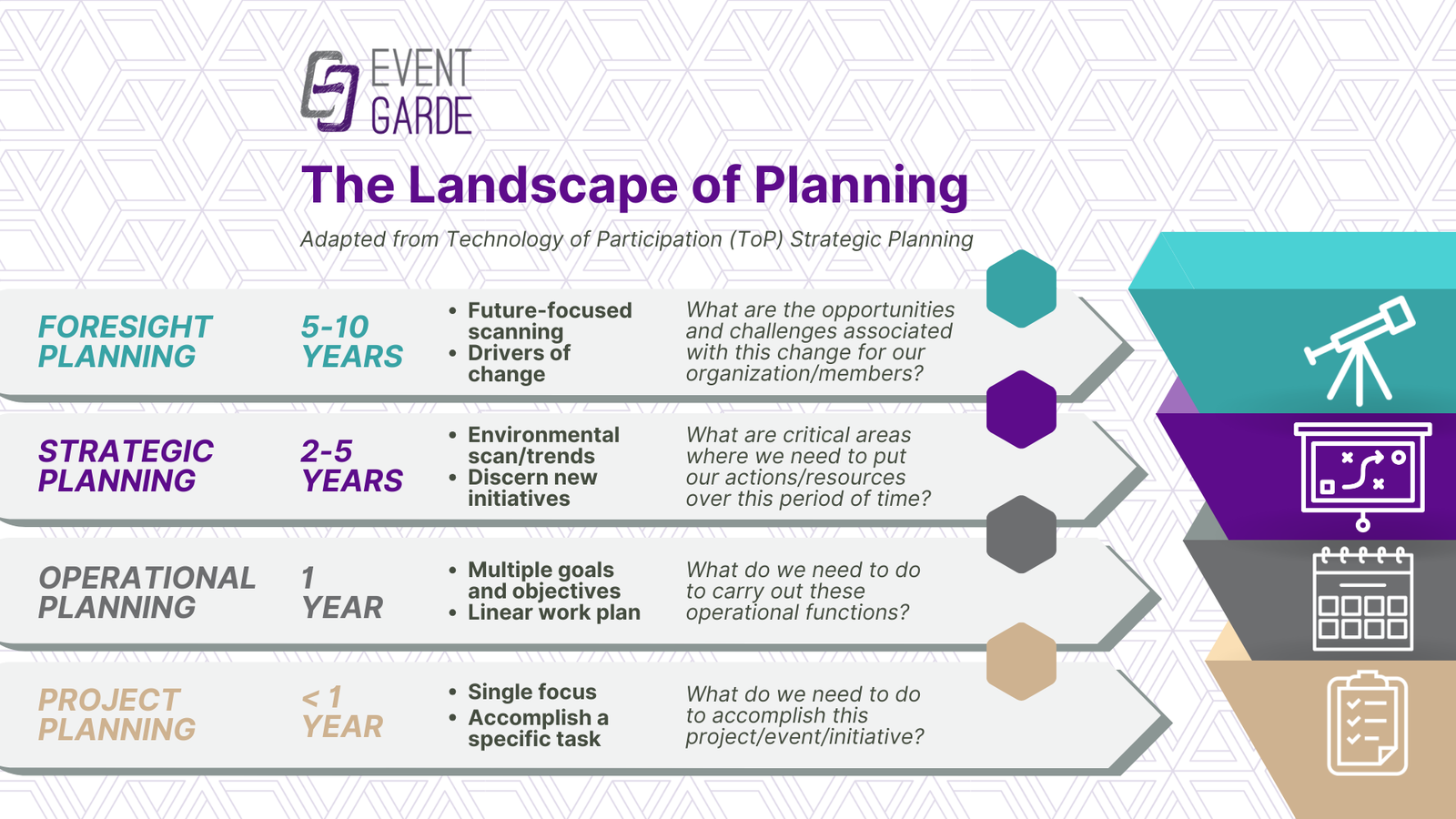
Adapted from the Technology of Participation (ToP) Strategic Planning course
In the ever-evolving landscape of organizational management, planning plays a pivotal role in charting a course for success. From envisioning long-term strategies to implementing short-term projects, various planning types serve distinct purposes in ensuring the vitality and growth of an organization. In this primer, we delve into the four essential planning types and how they impact your organization: foresight planning, strategic planning, operational planning, and project planning. Each type offers unique perspectives and methodologies tailored to different time horizons and objectives.
Foresight Planning: Embracing the Future
Popularized by ASAE’s ForesightWorks initiative, foresight planning is the compass that guides organizations through the complexities of tomorrow. Unlike other planning types, foresight planning is characterized by its long-term perspective, typically spanning five to 10 years or more into the future. At its core, foresight planning involves future-focused scanning and identifying the drivers of change that will shape an industry. By asking key questions such as, "What are the opportunities and challenges associated with this change for our organization/members?" foresight planners equip organizations with the foresight needed to anticipate and adapt to emerging trends.
Opportunities:
- Anticipating market shifts: Foresight planning enables organizations to proactively identify emerging market trends and capitalize on new opportunities before competitors.
- Building resilience: By understanding potential challenges on the horizon, organizations can develop strategies to mitigate risks and build resilience against future uncertainties.
Challenges:
- Uncertainty and complexity: Predicting long-term trends in a rapidly changing environment is inherently challenging and requires a nuanced understanding of various factors.
- Resource allocation: Foresight planning often requires significant resources and may divert attention from more immediate concerns, necessitating careful resource allocation.
Strategic Planning: Setting the Course for Success
Strategic planning bridges the gap between vision and implementation, providing a roadmap for organizations to achieve their long-term objectives. Typically focused on a two to five year time horizon, strategic planning involves conducting environmental scans, analyzing trends, and discerning new initiatives critical to organizational success. Key questions such as, "What are critical areas where we need to put our actions/resources over this period of time?" guide strategic planners in prioritizing initiatives that align with the organization's mission, vision, and values.
Opportunities:
- Alignment of resources: Strategic planning ensures that resources are allocated effectively toward initiatives that support the organization's strategic priorities.
- Agility and adaptability: By regularly reviewing and adjusting strategic plans in response to changing circumstances, organizations can remain agile and adaptable in dynamic environments.
Challenges:
- Balancing short-term and long-term goals: Striking the right balance between addressing immediate needs and pursuing long-term objectives requires careful consideration and prioritization.
- Implementation hurdles: Translating strategic plans into actionable initiatives can be challenging, requiring strong leadership, clear communication, and effective change management strategies.
Operational Planning: Implementing with Precision
Operational planning serves as the blueprint for day-to-day activities, ensuring that organizations efficiently implement their strategic objectives. Focused on a shorter time horizon of about one year, operational planning involves setting multiple goals and objectives and developing a relatively linear work plan to achieve them. Key questions such as, "What do we need to do to carry out these operational functions?" guide operational planners in outlining the specific tasks and activities required to support broader strategic initiatives.
Opportunities:
- Improved efficiency: Operational planning streamlines workflows and processes, minimizing redundancy and maximizing efficiency in resource utilization.
- Enhanced accountability: By clearly defining roles, responsibilities, and performance metrics, operational planning enhances accountability and transparency within the organization.
Challenges:
- Operational silos: Fragmented communication and coordination between different functions, teams, or departments can hinder the implementation of operational plans, leading to inefficiencies and missed opportunities.
- Adapting to change: Operational plans may need to be adjusted in response to unforeseen circumstances or changes in market conditions, requiring flexibility and agility in implementation.
Project Planning: Delivering Results On Time & On Budget
Project planning focuses on the successful implementation of specific tasks or initiatives within a relatively short timeframe, typically less than one year. Unlike other planning types, project planning is characterized by its single focus and clear deliverables. Key questions such as, "What do we need to do to accomplish this project/event/initiative?" guide project planners in defining project scope, objectives, timelines, and resource requirements.
Opportunities:
- Clear milestones and deliverables: Project planning enables organizations to set clear milestones and deliverables, facilitating progress tracking and ensuring accountability.
- Resource optimization: By allocating resources efficiently and effectively, project planning minimizes waste and maximizes return on investment.
Challenges:
- Scope creep: Without proper oversight and control, projects may suffer from scope creep, leading to delays, budget overruns, and diminished outcomes.
- Stakeholder management: Balancing the needs and expectations of various stakeholders can be challenging, requiring effective communication and conflict resolution skills to ensure project success.
In navigating the planning landscape, organizations must leverage a diverse toolkit of planning types tailored to different time horizons and objectives. From foresight planning that anticipates future trends to project planning that delivers tangible results, each planning type offers unique opportunities and challenges. By embracing a holistic approach to planning and adopting best practices from each planning type, organizations can effectively navigate uncertainty, drive innovation, and achieve sustainable growth in industries that are constantly evolving.


